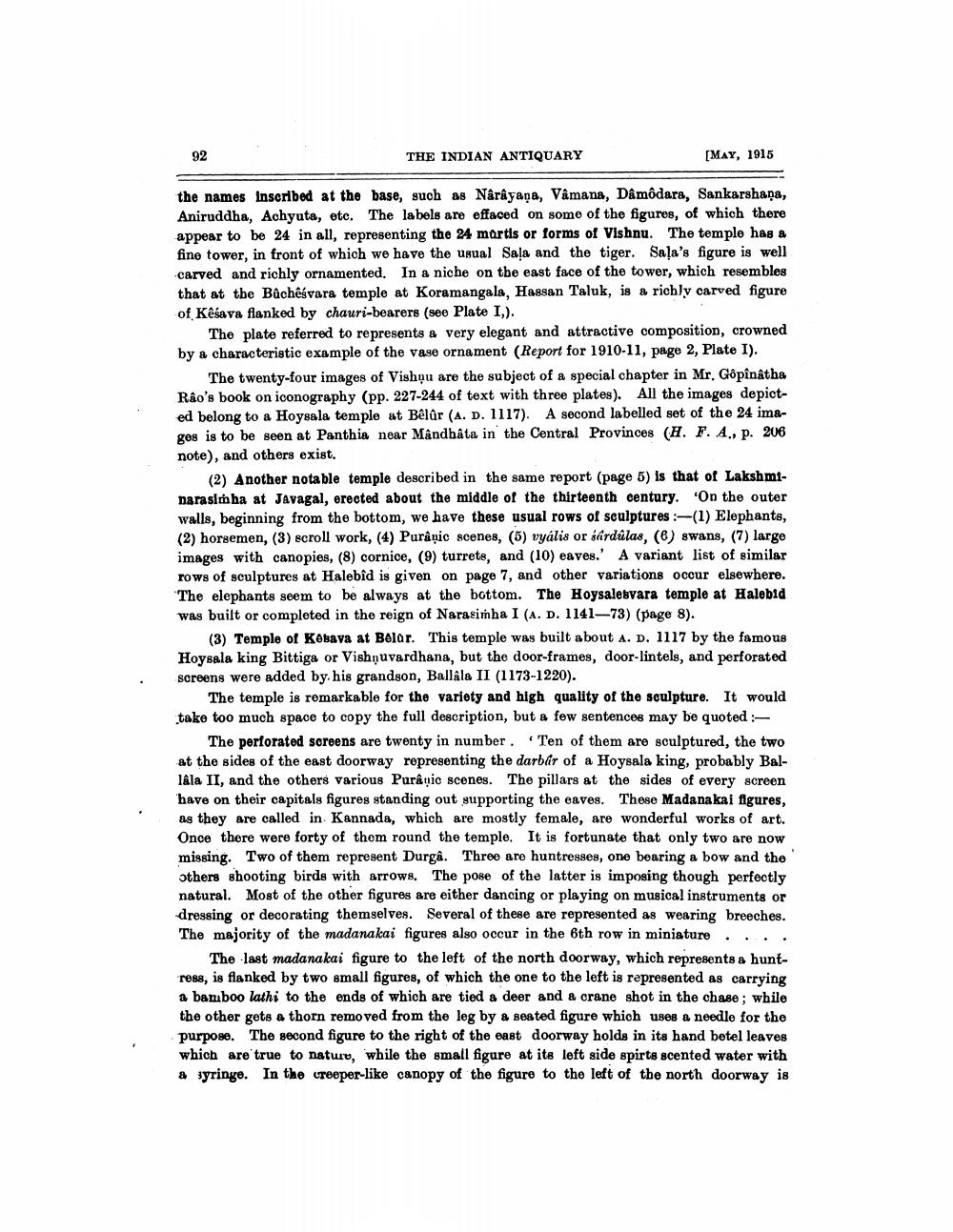________________
92
THE INDIAN ANTIQUARY
[MAY, 1915
the names inscribed at the base, such as Nârâyaņa, Vâmana, Dâmôdara, Sankarshana, Aniruddha, Achyuta, etc. The labels are effaced on some of the figures, of which there appear to be 24 in all, representing the 24 mortis or forms of Vishnu. The temple has a fine tower, in front of which we have the usual Sala and the tiger. Sala's figure is well carved and richly ornamented. In a niche on the east face of the tower, which resembles that at the Bachêsvara temple at Koramangala, Hassan Taluk, is a richly carved figure of Kéśava flanked by chauri-bearers (see Plate I).
The plate referred to represents a very elegant and attractive composition, crowned by a characteristic example of the vase ornament (Report for 1910-11, page 2, Plate I).
The twenty-four images of Vishụu are the subject of a special chapter in Mr. Gopinatha Râo's book on iconography (pp. 227-244 of text with three plates). All the images depicted belong to a Hoysala temple at Bêlûr (A. D. 1117). A second labelled set of the 24 images is to be seen at Panthia near Mândbâta in the Central Provinces (H. F. A., p. 206 note), and others exist.
(2) Another notable temple described in the same report (page 5) is that of Lakshminarasimha at Javagal, erected about the middle of the thirteenth century. On the outer walls, beginning from the bottom, we have these usual rows of sculptures -(1) Elephants, (2) horsemen, (3) scroll work, (4) Purâțic scenes, (5) vyális or ardúlas, () swans, (7) large images with canopies, (8) cornice, (9) turrets, and (10) eaves.' A variant list of similar rows of sculptures at Halebid is given on page 7, and other variations occur elsewhere. The elephants seem to be always at the bottom. The Hoysalesvara temple at Halebid was built or completed in the reign of Narasimha I (A.D. 1141-73) (page 8).
(3) Temple of Kobava at Belar. This temple was built about A. D. 1117 by the famous Hoysala king Bittiga or Vishnuvardhana, but the door-frames, door-lintels, and perforated screens were added by his grandson, Ballâla II (1173-1220).
The temple is remarkable for the variety and high quality of the sculpture. It would take too much space to copy the full description, but a few sentences may be quoted :
The perforated screens are twenty in number. Ten of them are sculptured, the two at the sides of the east doorway representing the darbar of a Hoysala king, probably Ballâla II, and the others various Purânic scenes. The pillars at the sides of every screen have on their capitals figures standing out supporting the eaves. These Madanakai figures, as they are called in Kannada, which are mostly female, are wonderful works of art. Once there were forty of them round the temple. It is fortunate that only two are now missing. Two of them represent Durga. Three are huntresses, one bearing a bow and the others shooting birds with arrows. The pose of the latter is imposing though perfectly natural. Most of the other figures are either dancing or playing on musical instruments or dressing or decorating themselves. Several of these are represented as wearing breeches. The majority of the madanakai figures also occur in the 6th row in miniature...
The last madanakai figure to the left of the north doorway, which represents a huntress, is flanked by two small figures, of which the one to the left is represented as carrying a baniboo lathi to the ends of which are tied a deer and a crane shot in the chase; while the other gets a thorn removed from the leg by a seated figure which u888 a needle for the purpose. The second figure to the right of the east doorway holds in its hand betel leaves which are true to nature, while the small figure at its left side spirte scented water with & syringe. In the creeper-like canopy of the figure to the left of the north doorway is




